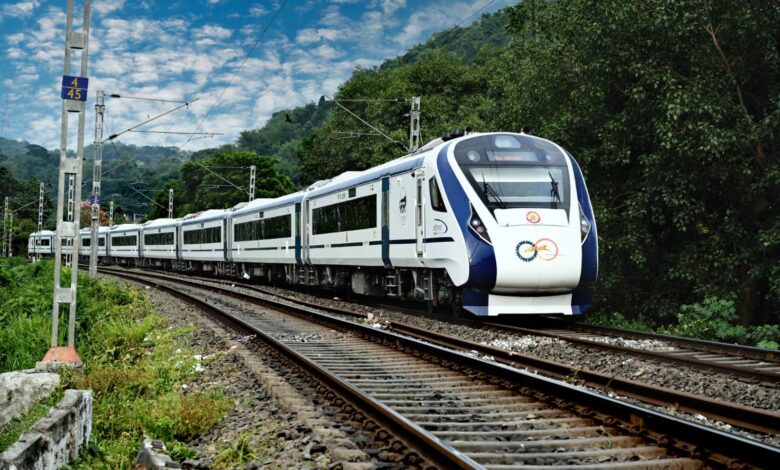Railway Budget 2024-2025: Key Revenue, Expenditure, and Allocation Insights Revealed
Explore the details of revenue growth, capital support, and expenditure strategies

In a pivotal development for India’s railway infrastructure, the Railway Budget for the fiscal year 2024-2025 has been unveiled, highlighting crucial aspects of revenue, expenditure, and financial allocations. Here’s a detailed breakdown of the key figures and allocations:
Revenue Generation:
The Railway Budget for 2024-2025 forecasts a substantial rise in Gross Traffic Receipts, emphasizing a proactive approach to revenue enhancement. Here’s a comparative look at the revenue streams:
- Gross Traffic Receipts: The anticipated Gross Traffic Receipts for 2024-2025 stand at ₹278,100.00 crore, showcasing an increase from the previous fiscal year’s revised estimate of ₹257,900.00 crore. This includes receipts from passengers, freight, other coaching services, sundry revenues, and traffic suspense adjustments.
- Receipts from Passengers are projected to rise to ₹80,000.00 crore from ₹73,000.00 crore in the revised estimate of 2023-2024.
- Freight earnings are expected to reach ₹180,000.00 crore, up from ₹169,000.00 crore in the revised estimates.
- Miscellaneous Receipts: This category, covering diverse sources such as penalties, museum revenues, and recruitment boards, is estimated at ₹400.00 crore for the upcoming fiscal year, reflecting an increase from ₹700.00 crore in the previous year.
- Total Revenue Receipts: Combining Gross Traffic Receipts and Miscellaneous Receipts, the total revenue expected for 2024-2025 is ₹278,500.00 crore, marking a strategic growth trajectory.
Capital Support and Expenditure:
The Railway Budget outlines a robust framework for capital investments and operational expenditures crucial for enhancing service quality and network expansion:
- Capital Support from Government: The budgetary support from the Government of India for 2024-2025 is set at ₹252,200.00 crore, indicating a significant contribution to infrastructure development and modernization within the railway sector.
- Extra Budgetary Resources (EBR): While the EBR for the fiscal year is projected at ₹10,000.00 crore, down from ₹17,000.00 crore in the previous fiscal, these resources continue to play a pivotal role in financing critical railway projects.
- Total Receipts including EBR: The cumulative receipts, including both operational revenues and budgetary support along with EBR, are expected to reach ₹540,700.00 crore, underscoring a balanced financial strategy aimed at sustainable growth and operational efficiency.
Expenditure Profile:
In line with revenue projections, the expenditure profile for 2024-2025 is structured to optimize resource allocation while maintaining fiscal prudence:
- Total Working Expenses: Operational costs, including ordinary working expenses, appropriations to pension and depreciation reserve funds, are estimated at ₹273,000.00 crore, reflecting a meticulous approach to financial management.
- Miscellaneous Expenditure: This category encompasses diverse expenditures ranging from administrative costs to developmental appropriations, totaling ₹2,700.00 crore, aligning with operational necessities and strategic initiatives.
- Total Expenditure including EBR and Budgetary Support: The comprehensive expenditure for the fiscal year, inclusive of operational expenses and financial support from EBR and the government, is projected at ₹537,900.00 crore, ensuring a disciplined approach towards fiscal sustainability and operational efficacy.
Financial Allocations and Ratios:
- Net Revenue and Appropriations: The net revenue, after deducting total working expenses, is anticipated to be ₹2,800.00 crore, emphasizing a positive financial outlook and effective utilization of resources.
- Appropriation to Development Fund and Rashtriya Rail Sanraksha Kosh (RRSK): The budget allocates ₹1,000.00 crore each to the Development Fund and RRSK, underscoring the commitment towards infrastructural development and passenger safety initiatives.
- Operating Ratio: The operating ratio for 2024-2025 is projected at 98.22%, demonstrating a slight improvement from the previous fiscal year’s figures, indicative of enhanced operational efficiencies and cost management practices.
Conclusion:
The Railway Budget for 2024-2025 presents a comprehensive financial roadmap aimed at bolstering India’s railway infrastructure through strategic revenue generation, prudent financial management, and targeted capital investments. With a focus on enhancing service delivery, expanding network capacities, and ensuring passenger safety, the budget sets the stage for transformative growth in the country’s transportation sector.




